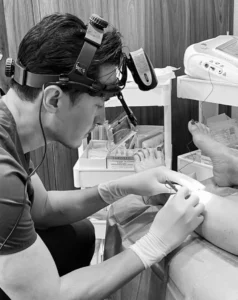Injection Sclerotherapy

Injection Sclerotherapy is a minimally invasive procedure used to treat spider veins, those small and often visible vessels that lie just beneath the skin’s surface. While these veins aren’t usually harmful, some people choose to address them for cosmetic reasons or to ease symptoms such as mild aching, swelling, or a burning sensation. The convenience of Injection Sclerotherapy lies in its simplicity: it can be performed in a doctor’s office and requires very little downtime, which means most patients can return to their normal routines with minimal disruption.
How Injection Sclerotherapy Works
During this procedure, a sclerosant solution is injected directly into the affected veins. The solution irritates the inner lining of the vessel, prompting it to collapse and seal shut. Over time, the body gradually absorbs these treated veins, while rerouting blood flow to healthier vessels. As a result, you’re likely to see both improved circulation and a noticeable reduction in the appearance of spider veins. In some cases, Injection Sclerotherapy can also be used to address certain types of small varicose veins.
What to Expect During the Procedure
Most Injection Sclerotherapy sessions last between 30 and 45 minutes, depending on how many veins are being treated. Because the procedure does not typically require anesthesia, patients often describe the sensation as similar to a quick pinprick. After the sclerosant is injected, compression bandages or stockings are placed on the treated area to help close off the veins and support healing. These compression wraps also encourage your body to adapt quickly, making the procedure both efficient and relatively comfortable.
For many patients, the convenience of resuming daily activities shortly after treatment is a major advantage. Whether you need to head back to work or simply prefer minimal time away from your usual routine, the “walk-in, walk-out” nature of Injection Sclerotherapy has made it a popular choice for decades.
Post-Procedure Care and Recovery
Although Injection Sclerotherapy is minimally invasive, proper care after the procedure can help you achieve the best results. You’ll typically be advised to move around and walk shortly after treatment, which helps maintain healthy circulation and prevents blood from pooling in the legs. Your doctor may recommend wearing compression stockings for about two weeks, as these garments reduce swelling and support the healing of treated veins.
It’s also wise to avoid extended sun exposure to the treated areas. The skin where the sclerosant was injected can sometimes become sensitive, and too much sun can increase the likelihood of pigmentation changes or other skin discolorations. In most cases, side effects like bruising or mild redness resolve fairly quickly, and any lingering discoloration or tiny scabs typically fade over a few weeks or months.
Potential Risks and Side Effects
Injection Sclerotherapy is widely regarded as safe, but as with any medical procedure, there are potential side effects. Minor bruising, raised red areas, or small skin sores can appear around the injection sites. These generally improve on their own, although some changes in skin pigmentation may last for a few months before fading completely. It’s not uncommon for spider veins to look more pronounced immediately following treatment before they eventually diminish.
Rarely, patients may develop phlebitis, which is an inflammation of the vein, or have an allergic reaction to the sclerosant solution. In extremely rare cases, blood clots can form in deeper veins, a condition known as deep vein thrombosis (DVT). It is always important to discuss your medical history and any concerns with your healthcare provider so they can tailor the treatment to your specific needs.
Who Benefits from Injection Sclerotherapy?
Anyone bothered by the appearance of spider veins or minor varicose veins may find Injection Sclerotherapy beneficial—whether the motivation is purely cosmetic or driven by mild discomfort in the legs. Because this procedure is quick, requires no general anesthesia, and is relatively low risk, it appeals to those seeking a convenient, time-tested option to improve the look and health of their leg veins. Results may vary from person to person, and multiple sessions could be necessary if you have a large number of spider veins.
If you’re considering Injection Sclerotherapy to address your spider veins, reach out to Dr. Darryl Lim to schedule a consultation and learn how this treatment can be customized to meet your individual needs.
This information is provided as a general guideline and should not replace professional medical advice. Always consult with your healthcare provider for recommendations tailored to your situation.
FAQ's about Injection Sclerotherapy
Yes, injection sclerotherapy is often an excellent choice for addressing spider veins, serving as a minimally invasive procedure capable of effectively diminishing their appearance.
However, it’s crucial to first assess whether the larger, underlying veins possess incompetent valves, ascertainable through an ultrasound scan. Undertaking treatment for spider veins without addressing any underlying venous reflux can lead to unsatisfactory results characterized by a higher risk of recurrence and suboptimal cosmetic outcomes.
No, sclerotherapy may not be suitable for everyone. Patients with certain medical conditions or those who are pregnant may not good candidates for this treatment.
The cost of injection sclerotherapy can vary depending on several factors including the extent and location of the spider veins.
Insurance coverage for sclerotherapy varies depending on your insurance provider and the specific terms of your policy. It’s often considered a cosmetic procedure and may not be covered. Our clinic can assist you with insurance queries and provide detailed information on payment options.
There is minimal downtime associated with injection sclerotherapy. Most patients return to their normal activities immediately following the procedure.
The needles used for injection sclerotherapy are very fine, and most patients experience minimal discomfort during the procedure. Some may feel slight stinging or cramps when the solution is injected.
While sclerotherapy is effective in eliminating the treated veins, it does not prevent new spider veins from forming. The risk of recurrence is higher if there is untreated venous reflux in the larger veins in your legs.
The number of sessions needed can vary depending on the extent and location of the spider veins. It is not uncommon to require 3-4 sessions for comprehensive treatment of your spider veins. Each session should be performed at least 2-3 months apart.
Yes, besides sclerotherapy, there are other treatment options like laser therapy for your spider veins.
Should there be an underlying vein reflux disorder, endovenous procedures like Radiofrequency Ablation or Clarivein can help to mitigate the risk of recurrence of your spider veins. Dr. Lim can discuss these options with you and help determine which treatment combination is most suitable for your condition.
It’s not uncommon for treated veins to appear darker initially after sclerotherapy. This usually improves over time as the body absorbs the treated veins.
Results can vary, but many patients notice an improvement in the appearance of spider veins within a few weeks, with optimal results typically seen within 3 months.
Post-procedure instructions typically include avoiding strenuous exercise for a few days, wearing compression stockings, and avoiding sun exposure to the treated areas.
You might experience some minor discomfort, bruising, inflammation or hyperpigmentation at the injection sites. These symptoms usually subside over time.
Absolutely! Walking is encouraged after the procedure to help promote blood flow and enhance the healing process.
Sclerotherapy rarely causes scarring, and any injection-related marks or hyperpigmentation typically fade over time (within 3-6 months).
The duration can vary, but typically, compression stockings are worn for about 2 weeks post-procedure.
Maintaining a healthy lifestyle, exercising regularly, maintaining a healthy weight, and wearing compression stockings can help in preventing the development of new spider veins.
It’s typically recommended to postpone sclerotherapy if you are planning to become pregnant soon, as hormonal changes during pregnancy can affect veins.


